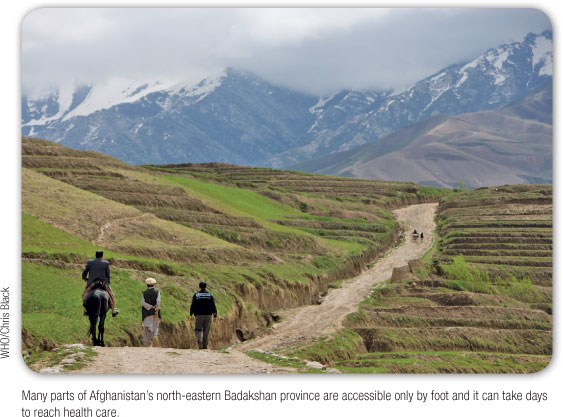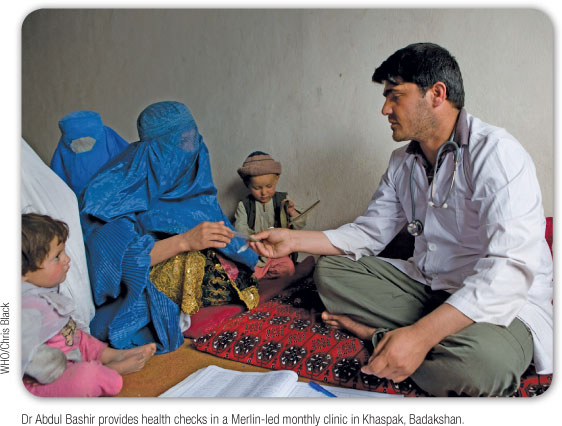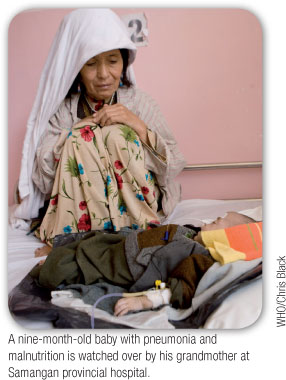NEWS
Rough roads to better care
Afghanistan is rebuilding its health system almost from scratch. In our continuing series on health financing, Julius Cavendish reports on a system sustained mostly by donor aid.
Mohammad Qasim, a portly man from southern Afghanistan, has criss-crossed some of the most dangerous terrain on earth in search of a cure for his haemorrhoids. Sitting on a hospital bed in Kabul, the Afghan capital, he explained how he had travelled down dirt roads dotted with homemade mines to see doctors capable of treating his condition. "It's a big problem for me," he says. "A lot of people with this problem haven't been cured and now they're in big pain. I am trying to solve it before it gets that bad."

At clinic after clinic Qasim says doctors prescribed pills that had no effect, or left him feeling worse. From his home of Gereshk he went south to the provincial capital of Lashkar Gah. From there he made the difficult 500 kilometre overland journey to Kabul, and back again. He is now in Kabul a second time, about to undergo surgery after various medications have failed to ease the pain. "I took a lot of pills," he says. "Now I'm just trying to be careful with my diet." He reckons he has spent around US$ 200 on tablets, doctor's fees and transport - the equivalent of three months' pay.
The lengths to which Qasim has gone may seem extreme, but many Afghans venture back and forth across their ravaged country to seek medical attention. In the same hospital in Kabul was a man from the suburbs of the northern province of Takhar, who had made the day-and-a-half journey across the backbone of the Hindu Kush to get orthopaedic treatment.
Another patient had spent the past month travelling between Kabul and his home in Ghazni province - along one of the country's most dangerous highways - for an operation, and then further care after complications set in. In the southern city of Kandahar, one person interviewed derided the regional hospital as a place you go to "if you want to die". Some 60% of patients in the Pakistani city of Quetta are said to be Afghans who prefer travelling abroad to making do with the health-care facilities at home.
Since the overthrow of the Taliban regime in 2001 and the ensuing flood of aid money, the Afghan government and donors have established a nationwide health-care system almost from scratch. The government has contracted nongovernmental organizations to provide a basic package of services in areas that it cannot cover. This arrangement has left the government and more precisely the Ministry of Health to focus on a stewardship role that involves policy and strategy setting, coordination, contract management and monitoring and evaluation.
Despite its flaws, health-care experts say the funding and delivery of health care in Afghanistan have taken remarkable strides over the past few years. Merlin is a nongovernmental organization that delivers health services to people living in inaccessible regions, such as Badakhshan province in north-eastern Afghanistan. "The gains...have been fantastic," says Ben Mascall, country director for Merlin. "Some of the people we reach have never seen a doctor before," he says. Although some serious medical conditions require treatment that is not available, the presence of basic community clinics helps limit out-of-pocket expenses for minor complaints.
Although there have been enormous gains, Dr Abdul Wali Ghayur, from the Ministry of Public Health, admits that "by all measures, the people of Afghanistan fare far worse, in terms of their health, than any other country of the region". He also claims that the services delivered to the population over the last six years have increased substantially with impressive results. "Now attention should be paid to improve the quality of the Basic Package of Health Services, improve hospital and referral systems and initiate partnerships with private providers in the hospital sector to make sure the health problems are addressed. This will require sustained efforts of all partners."
Financing for the health system comes from three main sources: external funding from donors, public funding from the government and out-of-pocket spending by patients. Community health insurance is not known in Afghanistan: pilots held in 2004-2006 were not promising and the government has no concrete plans to introduce it.
Of the sources of funding, donor contributions exceed government spending by a ratio of more than nine to one, with foreign assistance to Afghanistan's health sector standing at just over US$ 223 million for 2008, according to government figures. The three main donors are The World Bank, the United States Agency for International Development and the European Commission. Significant contributions also come from several United Nations agencies, the GAVI Alliance and the Global Fund to Fight AIDS, Tuberculosis and Malaria.

Meanwhile, a European Commission report suggests that out-of-pocket spending makes up somewhere between 73% and 79% of the total. A separate estimate by WHO puts the figure at a more modest 60%. (The discrepancy is an indication of how difficult reliable data is to come by in Afghanistan.)
But in either case, "the most important thing in a poor country like this is the out-of-pocket expenses," says WHO medical officer, Dr Ahmed Abd El Rahman. "Afghanistan has made substantial progress in health care over the past few years. But the strange thing is that while the public sector is growing, the private sector is flourishing more."
There are several reasons for this. First is the overall lack of public resources facing the health sector. Research from 2003 into how much the provision of a basic health-care package would cost in Afghanistan came back with a figure of US$ 4.55 per capita - a figure that has been cited repeatedly since then. But the Ministry of Public Health's Wali Ghayur warns that: "considering the information constraints in conducting this exercise, it would seem that US$ 4.55 can only be a very vague indication of what costs might be."
Ilkhom Gafurov, a senior health adviser with the Swedish Committee for Afghanistan, says that level of funding is completely inadequate. "Maybe for 2003 it was okay to provide minimum services. Maybe that was acceptable to start with but, over the years, this was never reversed. WHO has been recommending US$ 20-30 per capita," he says.
The implications of underfunding are tremendous, he continues. "You basically have to sacrifice something to run something. You sacrifice training or you limit your services. If you have a low budget for health care and patients come, what do you do? You tell them they have to buy their medicines. So, although health care is declared to be free, in fact it is not. It pushes people to the private sector because they think they will receive better service. Patients perceive 'this clinic has a bad director, they don't have medicines. If I go to the private sector I will get a good doctor and there will be medicines'."
Compounding the costs for many patients is the perception that hospitals in Kabul are better than clinics nearby, no matter what the ailment - "so many [people who] could be treated at clinic level are treated in hospitals even though there are fewer hospitals than clinics," says Gafurov.
Afghanistan's forbidding geography also plays its part. Anecdotal evidence suggests that patients living in remote areas tend to head for large hospitals rather than small clinics if they do decide to seek medical attention. Clinics in Samangan, a province isolated by its mountainous terrain, receive roughly one third of the patients of those received in Laghman, where the terrain is gentler and there is access from the main road from Kabul to Pakistan.
In part, this may be because there is a better representation of women on the staff at Laghman - meaning expectant mothers and children prefer to receive treatment there. But Gafurov points out that there is also an element of wanting to do things properly. "If they have to make an effort to come down from scattered villages in the mountains, they would rather travel an extra 50 kilometres to get good service," he says.
The tendency for patients to choose tertiary health-care facilities ahead of clinics puts added strain on an already under-funded system. Patients often pay their own way to get better services, even in the public system where health care is nominally free. Experts say that it is impossible to gauge the extent to which unofficial payments occur in the health system. According to Gafurov, this is most common at tertiary level. "Patients make these kinds of payments in order to stay comfortable," he says. "It is something that happens frequently. Certainly it's a problem." But that said, "it is not extortion and it is only at the hospital level for very clear reasons - the hospitals are over-burdened. Patients will get [treatment] in any case but some people choose to accelerate the process."

